
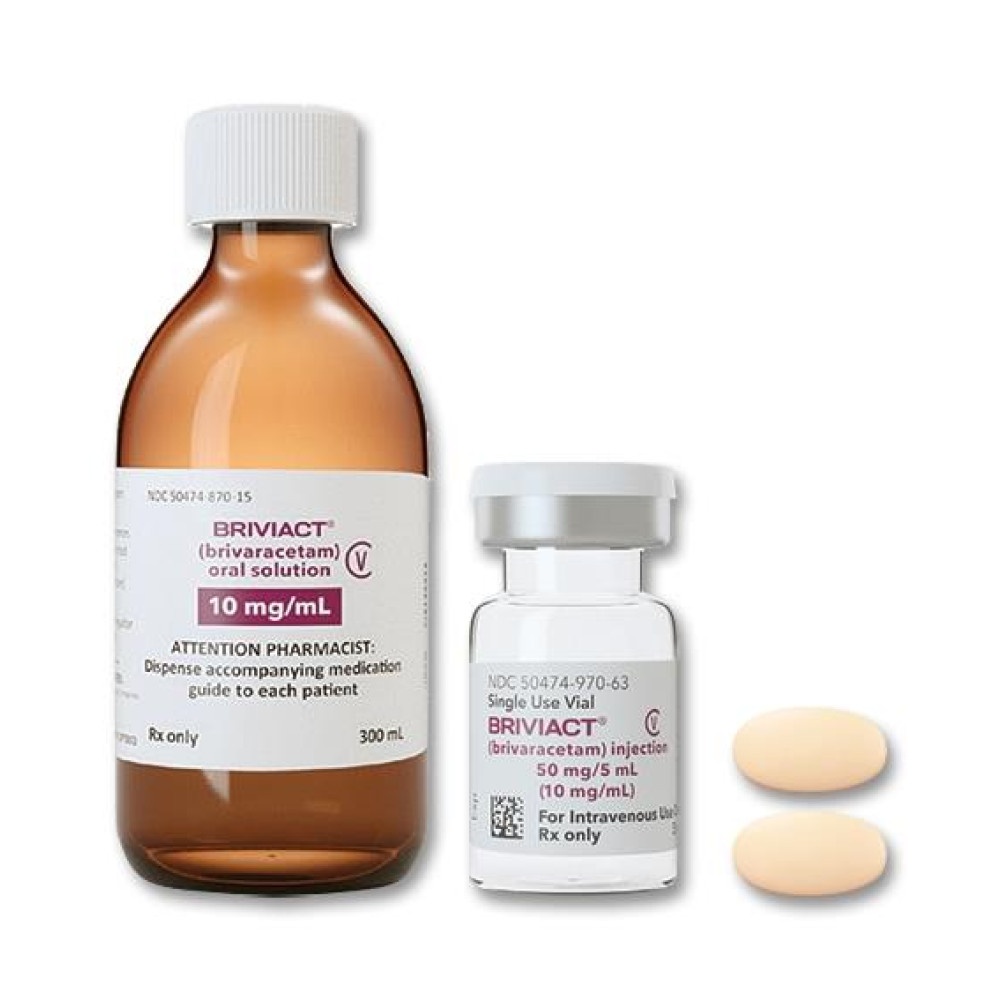
БРИВИАКТ 10 мг/мл ОРАЛЬНЫЙ РАСТВОР

Спросите врача о рецепте на БРИВИАКТ 10 мг/мл ОРАЛЬНЫЙ РАСТВОР

Инструкция по применению БРИВИАКТ 10 мг/мл ОРАЛЬНЫЙ РАСТВОР
Введение
Инструкция: информация для пациента
Бривиакт 10 мг/мл пероральная жидкость
бриварацетам
Прочитайте внимательно всю инструкцию перед началом приема этого лекарства, поскольку
она содержит важную информацию для вас.
- Сохраните эту инструкцию, поскольку вам может потребоваться перечитать ее.
- Если у вас есть какие-либо вопросы, проконсультируйтесь с вашим врачом или фармацевтом.
- Это лекарство было назначено только вам, и его не следует давать другим людям, даже если у них такие же симптомы, как у вас, поскольку оно может причинить им вред.
- Если вы испытываете побочные эффекты, проконсультируйтесь с вашим врачом или фармацевтом, даже если это побочные эффекты, которые не указаны в этой инструкции. См. раздел 4.
Содержание инструкции
- Что такое Бривиакт и для чего он используется
- Что нужно знать перед началом приема Бривиакта
- Как принимать Бривиакт
- Возможные побочные эффекты
- Хранение Бривиакта
- Содержание упаковки и дополнительная информация
1. Что такое Бривиакт и для чего он используется
Что такое Бривиакт
Бривиакт содержит активное вещество бриварацетам. Он принадлежит к группе лекарств, называемых «антиэпилептическими». Эти лекарства используются для лечения эпилепсии.
Для чего используется Бривиакт
- Бривиакт используется у взрослых, подростков и детей старше 2 лет.
- Он используется для лечения одного типа эпилепсии, сопровождающегося парциальными приступами с или без вторичной генерализации.
- Парциальные приступы - это приступы, которые начинаются с поражения только одной стороны мозга. Эти парциальные приступы могут распространиться на более крупные области обеих сторон мозга - это называется «вторичной генерализацией».
- Ваш врач назначил это лекарство, чтобы уменьшить количество приступов.
- Бривиакт используется вместе с другими лекарствами для лечения эпилепсии.
2. Что нужно знать перед началом приема Бривиакта
Не принимайте Бривиакт
- если вы аллергичны к бриварацетаму, другим подобным химическим соединениям, таким как леветирацетам или пирацетам, или к любому другому компоненту этого лекарства (перечисленному в разделе 6). Если вы не уверены, проконсультируйтесь с вашим врачом или фармацевтом перед приемом Бривиакта.
Предостережения и меры предосторожности
Проконсультируйтесь с вашим врачом или фармацевтом перед началом приема Бривиакта:
- Если вы имели мысли о причинении вреда себе или суициде. Небольшое количество людей, проходящих лечение антиэпилептическими лекарствами, такими как Бривиакт, имели мысли о причинении вреда себе или суициде. Если у вас есть такие мысли, немедленно свяжитесь с вашим врачом.
- Если у вас есть проблемы с печенью, ваш врач может потребовать скорректировать вашу дозу.
Дети
Не рекомендуется использовать Бривиакт у детей младше 2 лет.
Прием Бривиакта с другими лекарствами
Сообщите вашему врачу или фармацевту, если вы принимаете, недавно принимали или можете принимать любое другое лекарство.
В частности, сообщите вашему врачу, если вы принимаете любое из следующих лекарств, поскольку может потребоваться корректировка вашей дозы Бривиакта:
- Рифампицин, лекарство, используемое для лечения бактериальных инфекций.
- Трава Святого Иоанна (также известная как Hypericum perforatum), растительное лекарство, используемое для лечения депрессии и тревоги, а также других состояний.
Прием Бривиакта с алкоголем
- Не рекомендуется использовать это лекарство с алкоголем.
- Если вы принимаете алкоголь во время приема Бривиакта, негативные эффекты алкоголя могут увеличиться.
Беременность и лактация
Женщины детородного возраста должны обсудить использование контрацептивов с врачом.
Если вы беременны или кормите грудью, считаете, что можете быть беременной или планируете стать беременной, проконсультируйтесь с вашим врачом или фармацевтом перед использованием этого лекарства.
Не рекомендуется принимать Бривиакт, если вы беременны, поскольку неизвестны эффекты Бривиакта на беременность и плод.
Не рекомендуется кормить грудью во время приема Бривиакта, поскольку Бривиакт выделяется в грудное молоко.
Не прерывайте лечение без предварительной консультации с вашим врачом. Прерывание лечения может увеличить количество ваших приступов и нанести вред вашему ребенку.
Вождение и использование машин
- Вы можете чувствовать сонливость, головокружение или усталость во время приема Бривиакта.
- Эти эффекты более распространены в начале лечения или после увеличения дозы.
- Не управляйте транспортными средствами, не ездите на велосипеде или не используйте любые инструменты или машины, пока не проверите, как это лекарство влияет на вас.
Бривиакт пероральная жидкость содержитметилпараоксибензоат, натрий, сорбитол и пропиленгликоль
- Метилпараоксибензоат (Е218): может вызывать аллергические реакции (возможно, задержанные).
- Натрий: это лекарство содержит менее 23 мг натрия (1 ммоль) на миллилитр; это означает, что оно практически «не содержит натрия».
- Сорбитол (Е420) (тип сахара): это лекарство содержит 168 мг сорбитола в каждом миллилитре. Сорбитол является источником фруктозы. Если ваш врач указал вам (или вашему ребенку), что у вас есть непереносимость определенных сахаров, или если у вас диагностирована врожденная непереносимость фруктозы (ВНФ), редкое генетическое заболевание, при котором пациент не может расщеплять фруктозу, проконсультируйтесь с вашим врачом перед приемом этого лекарства.
- Пропиленгликоль (Е1520): это лекарство содержит максимум 5,5 мг пропиленгликоля в каждом миллилитре.
3. Как принимать Бривиакт
Следуйте точно инструкциям по приему этого лекарства, указанным вашим врачом. В случае сомнений проконсультируйтесь с вашим врачом или фармацевтом.
Вы будете принимать Бривиакт вместе с другими лекарствами для лечения эпилепсии.
Доза
Ваш врач рассчитает для вас правильную суточную дозу. Принимайте суточную дозу в две равные дозы, одну утром и одну вечером, примерно с интервалом 12 часов.
Подростки и дети, вес которых составляет 50 кг или более, и взрослые
- Рекомендуемая доза составляет от 25 мг до 100 мг дважды в день. Возможно, ваш врач позже решит скорректировать ее, чтобы найти для вас лучшую дозу.
В следующей таблице показаны только примеры доз, которые необходимо принимать, и какую шприц-наполнитель использовать. Ваш врач определит для вас подходящую дозу и какой шприц-наполнитель использовать, исходя из вашего веса.
Доза в мл, которую необходимо принимать дважды в день, и какой шприц-наполнитель использовать: для подростков и детей, вес которых составляет 50 кг или более, и взрослых: | ||||
Вес | Доза в мл (что соответствует 25мг) | Доза в мл (что соответствует 50мг) | Доза в мл (что соответствует 75мг) | Доза в мл (что соответствует 100мг) |
50 кг или более | 2,5 мл | 5 мл | 7,5 мл | 10 мл |
Использовать шприц-наполнитель 5мл (градируется синим цветом) | Использовать шприц-наполнитель 10мл (градируется черным цветом) |
Подростки и дети, вес которых составляет от 20 кг до менее 50 кг
- Рекомендуемая доза составляет от 0,5 мг до 2 мг на каждый килограмм веса тела дважды в день. Возможно, ваш врач позже решит скорректировать ее, чтобы найти для вас лучшую дозу.
В следующей таблице показаны только примеры доз, которые необходимо принимать, и какой шприц-наполнитель использовать. Ваш врач определит для вас подходящую дозу и какой шприц-наполнитель использовать, исходя из вашего веса.
Доза в мл, которую необходимо принимать дважды в день, и какой шприц-наполнитель использовать: для подростков и детей, вес которых составляет от 20 кг до менее 50 кг: | ||||
Вес | Доза в мл (что соответствует 0,5 мг/кг = 0,05 мл/кг) | Доза в мл (что соответствует 1 мг/кг = 0,1 мл/кг) | Доза в мл (что соответствует 1,5 мг/кг = 0,15 мл/кг) | Доза в мл (что соответствует 2 мг/кг = 0,2 мл/кг) |
20 кг | 1 мл | 2 мл | 3 мл | 4 мл |
25 кг | 1,25 мл | 2,5 мл | 3,75 мл | 5 мл |
30 кг | 1,5 мл | 3 мл | 4,5 мл | 6 мл* |
35 кг | 1,75 мл | 3,5 мл | 5,25 мл* | 7 мл* |
40 кг | 2 мл | 4 мл | 6 мл* | 8 мл* |
45 кг | 2,25 мл | 4,5 мл | 6,75 мл* | 9 мл* |
Использовать шприц-наполнитель 5мл (градируется синим цветом) | Для объемов от 0,5 мл до 5 мл использовать шприц-наполнитель 5 мл (градируется синим цветом)
|
Дети, вес которых составляет от 10 кг до менее 20 кг
- Рекомендуемая доза составляет 0,5 мг до 2,5 мг на каждый килограмм веса тела дважды в день. Врач вашего ребенка может решить скорректировать его дозу, чтобы найти для него лучшую дозу.
В следующей таблице показаны только примеры доз, которые необходимо принимать, и какой шприц-наполнитель использовать. Ваш врач определит для вас подходящую дозу и какой шприц-наполнитель использовать, исходя из вашего веса.
Доза в мл, которую необходимо принимать дважды в день, и какой шприц-наполнитель использовать для детей, вес которых составляет от 10 кг до менее 20 кг: | |||||
Вес | Доза в мл (что соответствует0,5 мг/кг = 0,05 мл/кг) | Доза в мл (что соответствует1,25 мг/кг = 0,125 мл/кг) | Доза в мл (что соответствует1,5 мг/кг = 0,15 мл/кг) | Доза в мл (что соответствует2 мг/кг = 0,2 мл/кг) | Доза в мл (что соответствует2,5 мг/кг = 0,25 мл/кг) |
10 кг | 0,5 мл | 1,25 мл | 1,5 мл | 2 мл | 2,5 мл |
12 кг | 0,6 мл | 1,5 мл | 1,8 мл | 2,4 мл | 3,0 мл |
14 кг | 0,7 мл | 1,75 мл | 2,1 мл | 2,8 мл | 3,5 мл |
15 кг | 0,75 мл | 1,9 мл | 2,25 мл | 3 мл | 3,75 мл |
Использовать шприц-наполнитель 5мл (градируется синим цветом) |
Пациенты с проблемами печени
Если у вас есть проблемы с печенью:
- Как подросток или ребенок, вес которого составляет 50 кг или более, или как взрослый, максимальная доза, которую вы будете принимать, составляет 75 мг дважды в день.
- Как подросток или ребенок, вес которого составляет от 20 кг до менее 50 кг, максимальная доза, которую вы будете принимать, составляет 1,5 мг на каждый килограмм веса тела дважды в день.
Как ребенок, вес которого составляет от 10 кг до менее 20 кг, максимальная доза, которую будет принимать ваш ребенок, составляет 2 мг на каждый килограмм веса тела дважды в день.
Как принимать Бривиакт пероральную жидкость
- Вы можете принимать Бривиакт пероральную жидкость самостоятельно или разбавленную в воде или соке непосредственно перед глотанием.
- Лекарство можно принимать с или без еды.
Инструкции для использования пациентами или опекунами:
В упаковке есть две шприц-наполнителя. Проверьте с вашим врачом, какой из них использовать.
- Для объема от 0,5 мл до 5 мл необходимо использовать шприц-наполнитель 5 мл (градируется синим цветом), который поставляется в упаковке, чтобы обеспечить точную дозировку.
- Для объемов более 5 мл и до 10 мл необходимо использовать шприц-наполнитель 10 мл (градируется черным цветом), который поставляется в упаковке, чтобы обеспечить точную дозировку
Шприц-наполнитель 5 мл | Шприц-наполнитель 10 мл |
Шприц-наполнитель 5 мл имеет 2 градирующие метки синего цвета: с интервалом 0,25 мл и 0,1 мл. | Шприц-наполнитель 10 мл имеет градирующие метки черного цвета с интервалом 0,25 мл. |
- Откройте флакон: нажмите на крышку и поверните ее против часовой стрелки (рисунок 1).

Следуйте этим шагам в первый раз, когда вы принимаете Бривиакт:
- Отделите адаптер шприц-наполнителя (рисунок 2).
- Вставьте адаптер в горлышко флакона (рисунок 3). Убедитесь, что он хорошо закреплен. Вам не нужно удалять адаптер после использования.
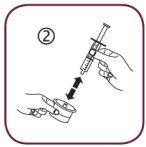
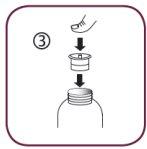
Следуйте этим шагам каждый раз, когда вы принимаете Бривиакт:
- Поместите шприц-наполнитель в отверстие адаптера (рисунок 4).
- Положите флакон вниз (рисунок 5).
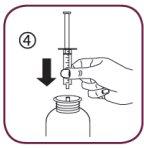
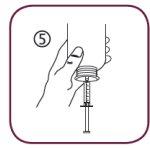
- Держите флакон вниз и используйте другую руку, чтобы наполнить шприц-наполнитель.
- Опустите поршень, чтобы наполнить шприц-наполнитель небольшым количеством раствора (рисунок 6).
- Затем поднимите поршень, чтобы удалить возможные пузырьки (рисунок 7).
- Опустите поршень до метки дозы в миллилитрах (мл) в шприц-наполнителе, назначенной вашим врачом (рисунок 8).
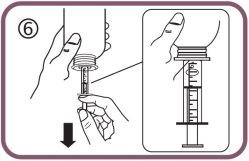
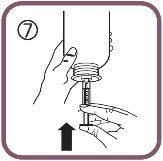
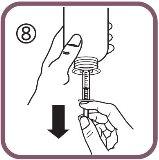
- Положите флакон вверх (рисунок 9).
- Удалите шприц-наполнитель из адаптера (рисунок 10).
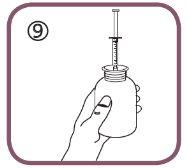
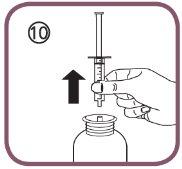
Вы можете выбрать один из двух способов принять лекарство:
- выпустите содержимое шприца в воду (или сок), нажав поршень до конца шприц-наполнителя (рисунок 11) - затем вам необходимо выпить всю воду (добавьте только столько, чтобы было легко выпить) или
- пейте раствор直接 из шприц-наполнителя без воды - выпейте все содержимое шприца (рисунок 12).
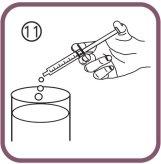
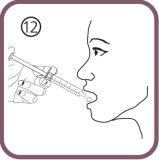
- Закройте флакон с помощью пластиковой резьбовой крышки (не нужно удалять адаптер).
- Чтобы очистить шприц-наполнитель, промойте его только холодной водой, перемещая поршень несколько раз вверх и вниз, чтобы собрать и выпустить воду, не разделяя два компонента шприца (рисунок 13).
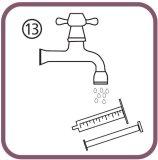
- Сохраните флакон, шприц-наполнитель и инструкцию в упаковке.
Продолжительность лечения Бривиактом
Бривиакт - это долгосрочное лечение - продолжайте принимать Бривиакт, пока ваш врач не скажет вам прекратить.
Если вы приняли больше Бривиакта, чем следует
Если вы приняли больше Бривиакта, чем следует, проконсультируйтесь с вашим врачом. Вы можете чувствовать головокружение и сонливость.
Также вы можете испытывать некоторые из следующих симптомов: чувство дискомфорта, чувство «кружения», проблемы с поддержанием равновесия, тревогу, чувство сильной усталости, раздражительность, агрессивность, трудности со сном, депрессию, мысли или попытки причинить вред себе или совершить суицид.
Если вы забыли принять Бривиакт
- Если вы забыли принять дозу, примите ее как можно скорее.
- Примите свою следующую дозу в то время, когда вы обычно ее принимаете.
- Не принимайте двойную дозу, чтобы компенсировать пропущенную дозу.
- Если вы не уверены, что делать, проконсультируйтесь с вашим врачом или фармацевтом.
Если вы прекратите лечение Бривиактом
- Не прекращайте лечение этим лекарством, если только ваш врач не скажет вам это. Это потому, что прекращение лечения может увеличить количество ваших приступов.
- Если ваш врач решит прекратить ваше лечение, он даст вам инструкции по постепенному отказу от Бривиакта. Это поможет избежать повторного появления ваших приступов или ухудшения.
Если у вас есть какие-либо другие вопросы о использовании этого лекарства, проконсультируйтесь с вашим врачом или фармацевтом.
4. Возможные побочные эффекты
Как и все лекарства, это лекарство может вызывать побочные эффекты, хотя не все люди испытывают их.
Очень частые:могут встречаться более чем у 1 из 10 пациентов.
- чувство сонливости или головокружения.
Частые:могут встречаться до 1 из 10 пациентов.
- грипп
- чувство сильной усталости (фатига)
- судороги, чувство вращения (вертиго)
- чувство тошноты и рвоты, запор
- депрессия, тревога, трудности со сном (бессонница), раздражительность
- инфекции носа и горла (такие как "обычная простуда"), кашель
- уменьшение аппетита
Редкие:могут встречаться до 1 из 100 пациентов
- аллергические реакции
- анормальные мысли и/или потеря контакта с реальностью (психотическое расстройство), агрессивность, нервозность (агитация)
- мысли или попытки причинить себе вред или совершить самоубийство: сообщите об этом своему врачу немедленно
- уменьшение количества белых кровяных клеток (так называемая "нейтропения") – которое появляется в анализах крови
Другие побочные эффекты у детей
Частые:могут встречаться до 1 из 10 пациентов.
- беспокойство и гиперактивность (психомоторная гиперактивность)
Сообщение о побочных эффектах
Если вы испытываете любой тип побочного эффекта, проконсультируйтесь со своим врачом или фармацевтом, даже если это возможные побочные эффекты, которые не указаны в этом описании. Вы также можете сообщить о них напрямую через национальную систему уведомления, включенную в Приложение V. Сообщая о побочных эффектах, вы можете внести свой вклад в предоставление более полной информации о безопасности этого лекарства.
5. Хранение Бривиакта.
- Храните это лекарство в недоступном для детей месте.
- Не используйте это лекарство после даты истечения срока годности, указанной на упаковке и флаконе после CAD. Дата истечения срока годности – последний день месяца, указанного.
- Это лекарство не требует особых условий хранения.
- После первого открытия флакона используйте в течение 8 месяцев.
- Лекарства не должны выбрасываться в канализацию или мусор. Спросите у своего фармацевта, как избавиться от упаковки и лекарств, которые вам больше не нужны. Таким образом, вы поможете защитить окружающую среду.
6. Содержание упаковки и дополнительная информация
Состав Бривиакта
- Активное вещество – бриварацетам.
- Каждый миллилитр (мл) содержит 10 миллиграммов (мг) бриварацетама.
Другие компоненты: цитрат натрия, ангидрид лимонной кислоты, пара-гидроксибензоат метила (Е218), кармелоза натрия, сукралоза, жидкий сорбитол (Е420), глицерин (Е422), аромат малины (пропиленгликоль (Е1520) 90% - 98%), очищенная вода.
Внешний вид продукта и содержание упаковки
Бривиакт 10 мг/мл пероральная раствор – слегка вязкая, прозрачная, бесцветная или желтоватая жидкость.
Стеклянный флакон емкостью 300 мл Бривиакта упакован в картонную коробку вместе с пероральной дозировочной ложкой емкостью 10 мл (черные деления), пероральной дозировочной ложкой емкостью 5 мл (синие деления) и адаптерами для ложек.
Владелец разрешения на маркетинг и производитель
Владелец разрешения на маркетинг
UCB Pharma, S.A., Allée de la Recherche 60, B-1070, Брюссель, Бельгия.
Производитель
UCB Pharma, S.A., Chemin du Foriest, B-1420 Брен-л'Аллюд, Бельгия.
Вы можете получить дополнительную информацию о этом лекарстве, обратившись к местному представителю владельца разрешения на маркетинг:
Бельгия UCB Pharma SA/NV Тел: + 32 / (0)2 559 92 00 | Литва UCB Pharma Oy Finland Тел: + 358 9 2514 4221 (Финляндия) |
Болгария ????? ?????????? ???? Тел: + 359 (0) 2 962 30 49 | Люксембург UCB Pharma SA/NV Тел: + 32 / (0)2 559 92 00 (Бельгия) |
Чехия UCB s.r.o. Тел: + 420 221 773 411 | Венгрия UCB Magyarország Kft. Тел: + 36-(1) 391 0060 |
Дания UCB Nordic A/S Тел: + 45 / 32 46 24 00 | Мальта Pharmasud Ltd. Тел: + 356 / 21 37 64 36 |
Германия UCB Pharma GmbH Тел: + 49 /(0) 2173 48 4848 | Нидерланды UCB Pharma B.V. Тел: + 31 / (0)76-573 11 40 |
Эстония UCB Pharma Oy Finland Тел: + 358 9 2514 4221 (Финляндия) | Норвегия UCB Nordic A/S Тел: + 47 / 67 16 5880 |
Греция UCB Α.Ε. Тел: + 30 / 2109974000 | Австрия UCB Pharma GmbH Тел: + 43-(0)1 291 80 00 |
Испания UCB Pharma, S.A. Тел: + 34 / 91 570 34 44 | Польша UCB Pharma Sp. z o.o. / VEDIM Sp. z o.o. Тел: + 48 22 696 99 20 |
Франция UCB Pharma S.A. Тел: + 33 / (0)1 47 29 44 35 | Португалия UCB Pharma (Produtos Farmacêuticos), Lda Тел: + 351 / 21 302 5300 |
Хорватия Medis Adria d.o.o. Тел: +385 (0) 1 230 34 46 | Румыния UCB Pharma Romania S.R.L. Тел: + 40 21 300 29 04 |
Ирландия UCB (Pharma) Ireland Ltd. Тел: + 353 / (0)1-46 37 395 | Словения Medis, d.o.o. Тел: + 386 1 589 69 00 |
Исландия Vistor hf. Тел: + 354 535 7000 | Словакия UCB s.r.o., организационная единица Тел: + 421 (0) 2 5920 2020 |
Италия UCB Pharma S.p.A. Тел: + 39 / 02 300 791 | Финляндия UCB Pharma Oy Finland Тел: + 358 9 2514 4221 |
Кипр Lifepharma (Z.A.M.) Ltd Тел: + 357 22 05 63 00 | Швеция UCB Nordic A/S Тел: + 46 / (0) 40 29 49 00 |
Латвия UCB Pharma OY Finland Тел: + 358 9 2514 4221 (Финляндия) | Великобритания(Северная Ирландия) UCB (Pharma) Ireland Ltd. Тел: + 353 / (0)1-46 37 395 |
Дата последнего обновления этого описания:
Другие источники информации
Подробная информация о этом лекарстве доступна на сайте Европейского агентства по лекарственным средствам: http://www.ema.europa.eu

Сколько стоит БРИВИАКТ 10 мг/мл ОРАЛЬНЫЙ РАСТВОР в Испании в 2025 году?
Средняя цена на БРИВИАКТ 10 мг/мл ОРАЛЬНЫЙ РАСТВОР в декабрь, 2025 года составляет около 119.89 евро. Финальная стоимость может зависеть от региона, конкретной аптеки и рецептурного статуса. Для точной информации лучше проверить онлайн или в ближайшей аптеке.
- Страна регистрации
- Средняя цена в аптеках119.89 EUR
- Активное вещество
- Требуется рецептДа
- Производитель
- Информация носит справочный характер и не является медицинской рекомендацией. Перед приемом любых препаратов проконсультируйтесь с врачом. Oladoctor не несет ответственности за медицинские решения, принятые на основе этого контента.
- Аналоги БРИВИАКТ 10 мг/мл ОРАЛЬНЫЙ РАСТВОРФорма выпуска: ТАБЛЕТКА, 100 мгАктивное вещество: БриварацетамПроизводитель: Laboratorios Cinfa S.A.Требуется рецептФорма выпуска: ТАБЛЕТКА, 25 мгАктивное вещество: БриварацетамПроизводитель: Laboratorios Cinfa S.A.Требуется рецептФорма выпуска: ТАБЛЕТКА, 50 мгАктивное вещество: БриварацетамПроизводитель: Laboratorios Cinfa S.A.Требуется рецепт
Аналоги БРИВИАКТ 10 мг/мл ОРАЛЬНЫЙ РАСТВОР в других странах
Лучшие аналоги с тем же действующим веществом и терапевтическим эффектом.
Аналог БРИВИАКТ 10 мг/мл ОРАЛЬНЫЙ РАСТВОР в Poland
Врачи онлайн по БРИВИАКТ 10 мг/мл ОРАЛЬНЫЙ РАСТВОР
Консультация по дозировке, побочным эффектам, взаимодействиям, противопоказаниям и продлению рецепта на БРИВИАКТ 10 мг/мл ОРАЛЬНЫЙ РАСТВОР – по решению врача и с учетом местных правил.







